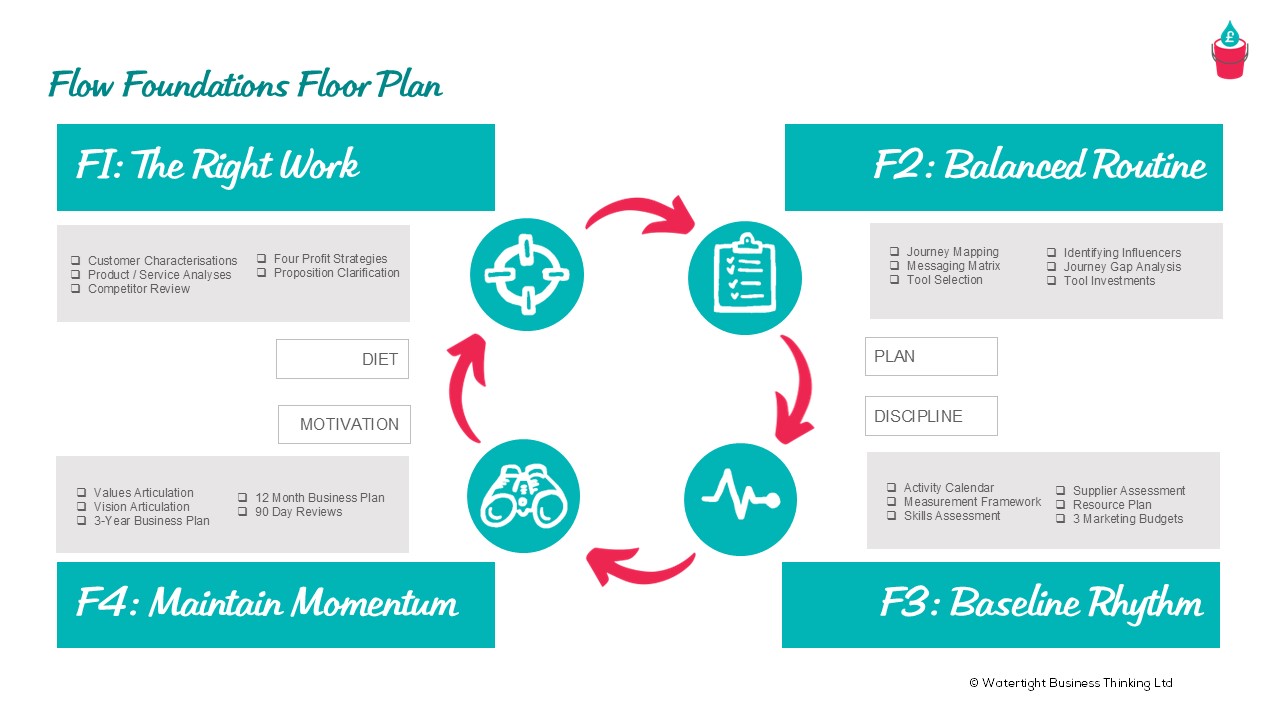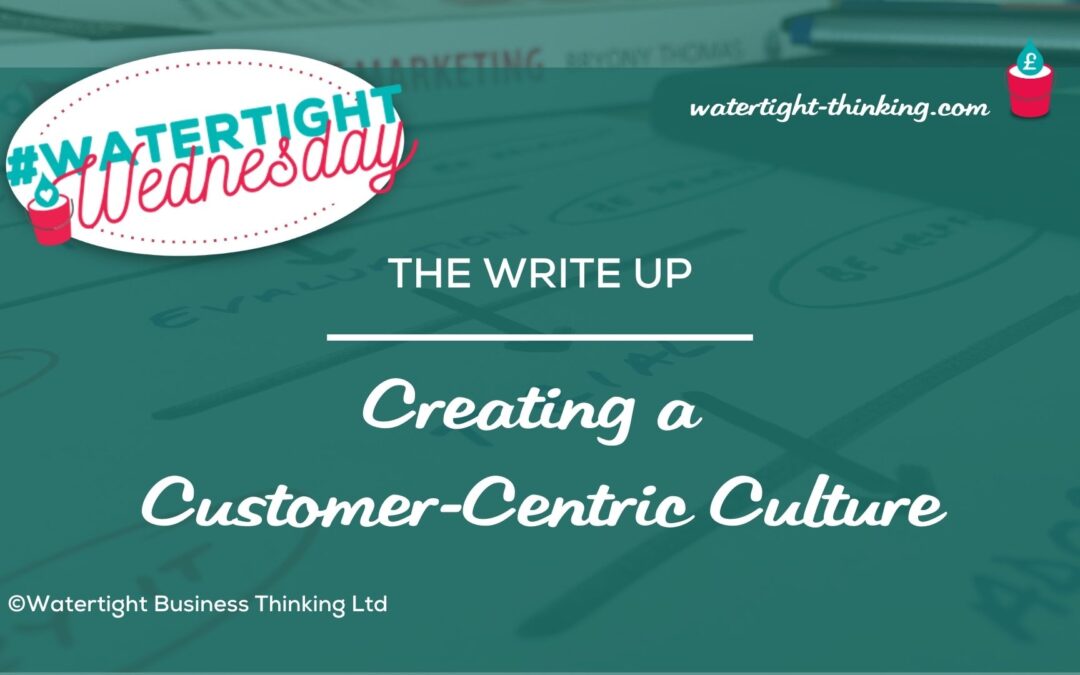Reading Time: 10 Minutes
“A lot of companies say they have the customer at the heart of their approach, but does that really stand up to scrutiny? There are numerous benefits to keeping your customers central, but there are also challenges in ensuring the business is paying more than lip service to it. In this month’s roundtable we discussed what makes for customer-centricity and how to overcome some of the hurdles in achieving it.” ~ Rachael Wheatley, Managing Director | Watertight Business Thinking
Listen to the session podcast here
55-minute roundtable discussion on creating a customer centric culture.
It’ll come as no surprise to many of you that being customer centric and delivering consistently high levels of customer satisfaction are linked to better business performance, both profit and revenue growth. The Institute of Customer Service’s July 2024 index reports some other striking statistics:
- 45% of customers say that whether or not an organisation does the right thing in its business practices or impact on society influences their satisfaction.
- 56% of customers say their satisfaction with an organisation is influenced by whether they felt that organisation understood and cared for their situation and needs. In that group of customers, satisfaction rose to nearly 82%.
- 31% of customers prefer excellent service, even if they have to pay more.
Customer focus as part of your business DNA
So, how do organisations reach this state of customer-centricity? We started off by using our Flow Foundations Floor Plan to show how it can be embedded in your business. The Floor Plan is a way of organising your strategic and operational marketing and helps you map out what needs to be in place for the marketing – and wider business – to be successful.

Fourth Flow Foundation
This is where your vision, values and goals sit. The starting point is ensuring customer focus is a strategic priority at board level, seen as key driver of long-term value and one of the measures of success. You’re aiming for it to be articulated in culture, standards, values and behaviour.
First Flow Foundation
This is all about having the Right Work, at the intersection of profitable and purposeful work with customers that are good for your bank balance but also motivate your staff. Customer focus is framed here. This is where you will gain the insight through customer research and assess market opportunities with your customers. It’s where you gain clarity on what you’re selling and how it meets customers’ needs.
Second Flow Foundation
This is about having a Balanced Routine and the right marketing in place to support your customer’s buying journey. Customer focus is integrated into your plans here – marketing, sales and service – as well as extending to other operational teams. How does your IT team need to use tech to support customer centricity? How does finance deal with invoicing and customer queries? What’s the part your warehouse plays in delivering products to customers or HR ensuring they recruit the right people who will share your culture? This is where you map out your customer’s journey and create touchpoints to engage, even before they’re customers.
Don’t forget the three Leaks which, if plugged, will support customer focus: Leak 1 (Forgotten Customers), Leak 2 (Poor On-Boarding) and Leak 3 (Emotional Connection).
Third Flow Foundation
Consistency and rhythm in your marketing are what you’re aiming for here; doing enough to make a difference. Customer focus is delivered and measured here. It’s where customer surveys and NPS scores sit. It’s where you ensure that whatever you’re doing to achieve customer centricity happens regularly and consistently.
Resource
Sitting across all four Foundations is a commitment to invest in people, technology, infrastructure, and processes to deliver capacity, logistics and engagement with customers, with the ability to flex built in so you can change as needed in the future.
The five competencies to look for
Rhian Huxtable: “The first thing to recognise is the gap between what companies are promising and what is being delivered to clients. There’s often quite a large mismatch of around 20% in terms of what the client’s perception is and what the board thinks.”
Rhian shared five key competencies that show good customer centricity in an organisation (from Customer Experience Professionals Association – Competency Framework):
1. Customer insights and understanding.
2. Customer experience strategy.
3. Metrics, measurement and ROI.
4. Design, implementation and innovation.
5. Culture and accountability.
“But the first thing I want to say about creating a client centred organisation is you have to recruit client centric individuals. That is the fastest way you are going to be able to deliver.”
Aimee Blakemore agreed: “At Flourish we focus on hiring the right kind of people. We’ve done a couple of projects around employee value proposition which I think is important if you want to get your customers to engage.”
Challenges that cause friction – and how to overcome them
Another thing Flourish comes up against with their clients is interdepartmental communication, where the sales team and the marketing team, for example, are not talking to each other and there’s often a lot of information that the marketing team have that the sales team could utilise and vice versa.
They also focus on CRM technology to make sure the right systems are in place to support customer focus and ensure you store and use the information you have – it reduces time having it in one place.
Rachael Wheatley: “That talks to the importance of knowledge being shared so it’s corporate knowledge, not just sitting in one department.”
Alice Friday: “As a marketing team, you have that power of being able to cross a lot of departments and start those conversations, test what’s being said, run surveys. One of the things that worked well [for me] was a consistent customer survey, which then became action points to develop internally for the operations team. Getting the feedback of why people were happy or not happy helped to frame stories of what good looks like.”
Getting customer experience on the board agenda can be a challenge and one attendee asked a question about how to do that. CX is often seen as an operational issue although the evidence shows that those organisations who are truly customer centric have it as a strategic priority at board level.
Aimee Blakemore shared a couple of examples including working with a global organisation to implement a new customer relationship management programme to better utilise their technology but also improve customer engagement. As success built, more teams became interested because they could see the results. These ended up being an increase in sales from customers of 35%.
Natasha Milsted: “I love what Aimee said about working with one team and then that idea spread. Having a champion area and then you’re able to demonstrate the benefit and get other people on board.”
Rhian Huxtable: “Most boards are curious about the impact that good client strategy can bring. I tend to call these businesses passive; they know they need to do something, but they’re not quite sure what. The power of statistics is often the way to break through and get boards to listen.” He shared two that would get notice. The average Brit is prepared to pay 16% more for a great client experience and employees tend to deliver 1.7 times more than businesses that don’t deliver on that. Many businesses also don’t know what their 10 largest clients spend with them – or what opportunities there might be if they were to talk to their clients and grow sales through great client experience.
“To get this on the agenda, talk about what the sector more generally are doing and get a benchmark” and then comparing your organisations to others.
Bryony Thomas: “What about a business where the board sees customer centricity as absolutely critical but they’re not able to get the operations team to get beyond that? I’m just doing my day job attitude.”
Aimee Blakemore: “I think it might come down to the employee value proposition piece. If a company has a challenge with bringing the rest of their employees on board with something, then possibly changing the way that they incentivise their employees to work is going to be key to making a change. Take Waitrose for example – they’re already invested in the business because they all own a little part.”
Rachael Wheatley: “And being really clear about your expectations of people. It’s a two-way thing. Yes, of course motivating your employees but also saying, this is what we expect of people.”
Rhian Huxtable added: “Getting this culture across the organisation also includes looking at it at role level – what’s in it for me. People have a lot on their plate and customer interaction won’t be the most important thing. Incentivisation can work, as long as it doesn’t drive the wrong behaviours. Look at how customer centricity can make jobs more secure.”
Alice Friday: “I’ve worked for companies where customer experience is really established and it has been around bringing the operational team along with that vision. And I’ve done the flip side, where I am currently, which is a charity where customer experiences are a pretty new concept and I’m trying to move them from being product centred to customer centric. We’re on that journey with them.
“One of the best things I’ve ever had the opportunity to do is customer journey mapping with all levels of an organisation. Everyone from the CEO to the receptionist. It’s a really powerful way to understand what those touchpoints are, but also what people are taking accountability for and what you can control and influence. And getting that common understanding. But it doesn’t happen overnight.”
Rachael Wheatley: “It sounds like a question of planning out and recognising that it’s a marathon, not a sprint.”
Rhian Huxtable: “When journey mapping, make sure that the three parts of the journey are recognised: the process, employee engagement and client output. Also, I highly recommend that you use live customer data at each touchpoint so you understand what customers are currently thinking about that journey. Use their feedback to tell the story about experiences they’ve had.”
Bryony Thomas: “A word of caution on data you use – there needs to be enough volume for it to be predictive or meaningful. The other thing is that people tend to tie themselves in knots trying to map every single journey and every single touchpoint. It’s far more useful to have clusters of typical touchpoints rather than trying to map all 300 of them.”
Watertight Wisdom
Here’s what worked for us – eight nuggets from the session.
- Use our Flow Foundation Floor Plan (see above) to embed customer centricity at a strategic and operational level.
- Develop customer-centric competencies. Look at how these might be built in to people’s roles and job descriptions.
- Start with one team or department. Sharing your success will then interest others and it becomes easier to roll out a customer centric plan.
- Benchmark using meaningful metrics mapped to your customer journey.
- Use storytelling to bring good and bad customer experiences to life. This is the voice the customer and is hugely powerful in helping people to understand the importance of a great customer experience.
- Statistics are your friend in getting the attention of the board for customer centricity.
- Don’t forget the employee value proposition. Employee engagement and job satisfaction has a direct impact on customer experience.
- Use CRM technology to facilitate processes and information sharing.
To join the conversation at our next Watertight Wednesday marketing roundtable in December sign up here. We’ll be having a discussion about AI so do come along with any questions you have but have been too afraid to ask! We have two fabulous guests who will be bringing insight and answers. Do join us.

Rachael Wheatley
Managing Director, Watertight Thinking
Rachael brings over 30 years’ of marketing experience, with a particular focus on building and developing effective marketing teams that are able to act as a strategic driving force across an organisation. She has worked with Watertight since 2014 as a Master Practitioner and joined the business as MD in 2022.



